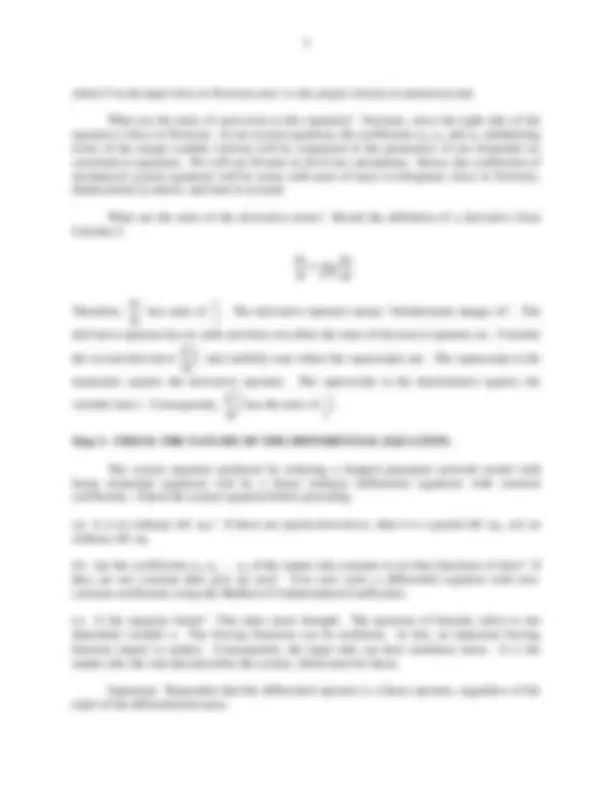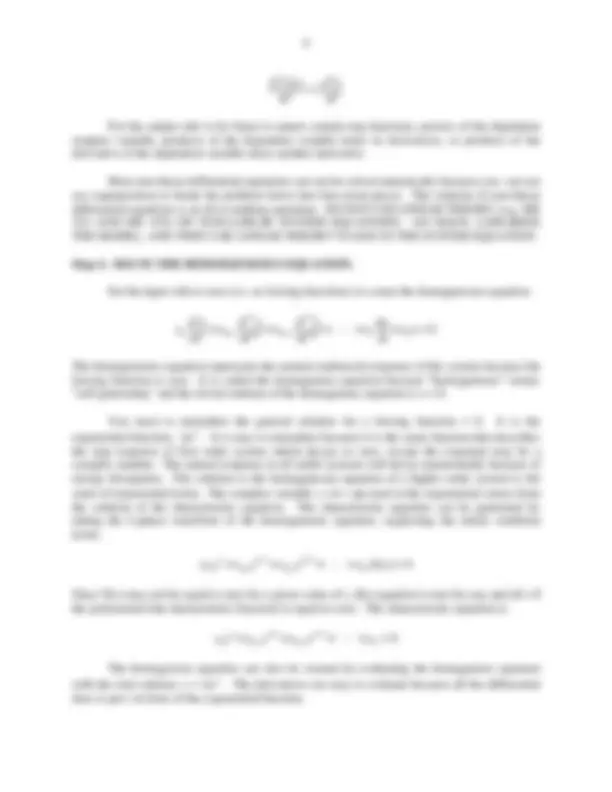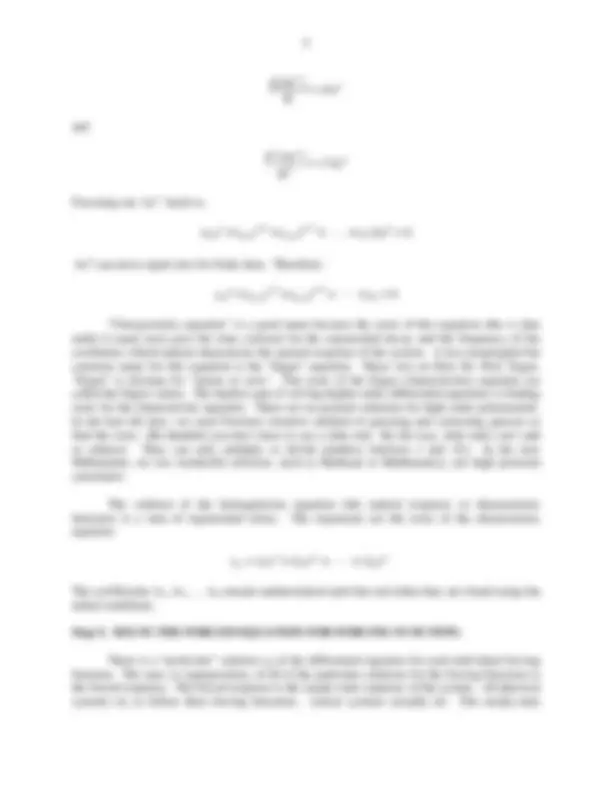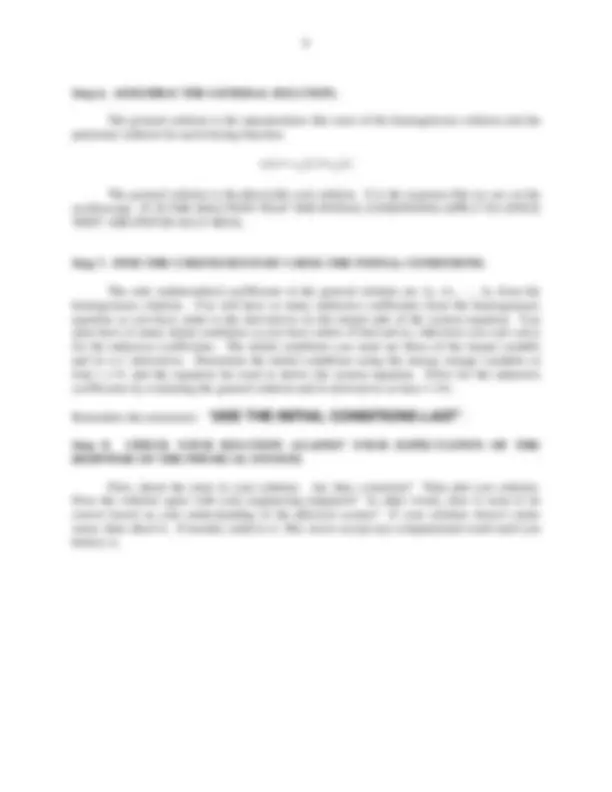






Study with the several resources on Docsity

Earn points by helping other students or get them with a premium plan


Prepare for your exams
Study with the several resources on Docsity

Earn points to download
Earn points by helping other students or get them with a premium plan
Community
Ask the community for help and clear up your study doubts
Discover the best universities in your country according to Docsity users
Free resources
Download our free guides on studying techniques, anxiety management strategies, and thesis advice from Docsity tutors
Material Type: Exam; Professor: Seeler; Class: Dynamics of Physical Systems; Subject: Mechanical Engineering; University: Lafayette College; Term: Spring 2005;
Typology: Exams
1 / 8

This page cannot be seen from the preview
Don't miss anything!





© Dr. Seeler Department of Mechanical Engineering Spring 2005 Lafayette College ME 352: Dynamics of Physical Systems and Electric Circuits
We can always solve a differential system equation using the appropriate numerical method, such as Runge-Kutta method, if the solution exists. However, we must also understand the analytical solution of ordinary differential equations in order to understand the physics of dynamic systems and to use design techniques developed from the analytical solution. Unfortunately, with a few exceptions, we are restricted in the type of differential system equation we can solve analytically to linear ordinary differential equations with constant coefficients.
The behavior of all real systems is non-linear to some degree. The simple test for linearity is: Does doubling the input, double the output? F = bv is a linear relationship: doubling v doubles F. F = bv^2 is a nonlinear relationship; doubling v does not double F. Linear elemental or constitutive equations are often only poor approximations of the behavior of components in real systems. Common machine elements with non-linear behavior are energy dissipaters (including Coulomb friction), transformers and transducers (which are subject to saturation) and power sources (subject to power limits). Linear ordinary differential equations with constant coefficients result from using linear elemental equations with constant elemental parameters, such as F , to model an energetic system, as we will in ME 352. We must use linear elemental equations, even though we know that they are only approximate, to produce a linear differential equation because our solution technique requires superposition. Superposition only works with linear equations. We will “linearize” these elements, even if it requires severe simplification, so that we can solve the resulting system equation.
= Kx
The “general” solution of linear ordinary differential equations with constant coefficients is the superposition (a.k.a. sum) of the solution to the homogeneous equation, created by setting the output variable side of the differential equation to zero, and of the particular solution(s) for each forcing function (a.k.a. input). The homogeneous equation represents the natural response of system to a disturbance. When an energetic system has reached steady-state, there is an equilibrium between the energy storages in the system. If the system is then disturbed by an input of energy, a new equilibrium must be reached. The homogenous response of a dynamic system describes how the system reaches its new energy equilibrium. All systems of practical interest have energy dissipation. Consequently the homogenous response is transient. It eventually decays to zero. The particular solution(s) are the steady-state response(s) of the system to a continuous (but possibly time varying) input (forcing function(s)). Both the transient (a.k.a. natural or homogeneous) and the steady-state (a.k.a. forced) responses occur when you apply an input to a system. Eventually, the transient response decays to zero and only the forced response remains. To reiterate, the general solution of the system equation is the superposition of transient response and steady-state response to each input.
Superposition can be used with differential equations because (1) the differential operator obeys the associative law. Proof:
dt dt dt
and (2) the differential operator is linear. Proof: if you double the input, you double the output:
d(2x) dx 2 dt dt
The consideration of whether or not a solution to the system equation exists is straightforward. In our case, a solution must exist because the system equation describes a physical system. If both the system and the input are physically realizable, then the solution of the system equation for that input is a physically realizable response of the system and it must exist. The only reasons a solution will fail to exist are if you made an error either (1) modeling the system or (2) deriving the system equation.
The Method of Undetermined Coefficients allows us to solve linear ordinary differential equations with constant coefficients by remembering a “generic” solution for the unforced “natural” response and the generic solutions for a small number of physically common forcing functions. The generic solutions have adjustable constants (the undetermined coefficients) to scale the amplitude, duration, frequency, etc. to fit the specific system equation, input, and initial conditions. The general solution is constructed by the superposition, or summation, of the natural and forced and the responses.
The Method of Undetermined Coefficients is as follows:
Step 1. SEPARATE THE FORCING FUNCTIONS AND OUTPUT VARIABLES.
n n 1 n 2 n (^) n n 1 (^) n 1 n (^2) n 2 1 0 1 2 n
d x d x d x dx a a a a a x f (t) f (t) f (t) dt dt dt dt
− −
Time is the independent variable in a dynamic system. All terms that do not have the output variable in them, x in this example, are the inputs to the system. They are the forcing functions. They force or excite the steady-state response of the system.
Step 2. CHECK UNITS OF EACH TERM IN THE EQUATION.
This is an important check. You are checking to see if you are adding apples and apples. All terms in a summation must have the same units, or they cannot be summed. If the units don’t check, then you are working with nonsense. Check now before you invest any more time in the solution. Consider a second order equation:
2 2 2 1 0
d v dv a a a v dt dt
n n n n
d (2x) d x 2 dt dt
For the output side to be linear it cannot contain trig functions, powers of the dependent (output) variable, products of the dependent variable times its derivatives, or products of the derivative of the dependent variable times another derivative.
Most non-linear differential equations can not be solved analytically because you can not use superposition to break the problem down into bite-sized pieces. The solution of non-linear differential equations is an all or nothing operation. DO NOT USE LINEAR THEORY (e.g. ME 352 AND ME 478) ON NON-LINEAR SYSTEM EQUATIONS. GO BACK, LINEARIZE THE MODEL, AND THEN USE LINEAR THEORY TO SOLVE THE SYSTEM EQUATION.
Step 4. SOLVE THE HOMOGENEOUS EQUATION.
Set the input side to zero (i.e. no forcing functions) to create the homogeneous equation.
n n 1 n 2 n (^) n n 1 (^) n 1 n (^2) n 2 1 0
d x d x d x dx a a a a a x dt dt dt dt
− −
The homogeneous equation represents the natural (unforced) response of the system because the forcing function is zero. It is called the homogenous equation because “homogeneous” means “self-generating” and the trivial solution of the homogenous equation is x = 0.
You need to remember the general solution for a forcing function = 0. It is the
exponential function,. It is easy to remember because it is the same function that describes the step response of first order system which decays to zero, except the exponent may be a complex number. The natural response in all stable systems will decay exponentially because of energy dissipation. The solution to the homogeneous equation of a higher order system is the sums of exponential terms. The complex variable s = σ + jω used in the exponential comes from the solution of the characteristic equation. The characteristic equation can be generated by taking the Laplace transform of the homogeneous equation, neglecting the initial condition terms.
Ae^ st
n n 1 n 2 (a sn a (^) n 1s a (^) n 2 s a )X(s) 0 0 − −
Since X(s) may not be equal to zero for a given value of s, this equation is true for any and all s if the polynomial (the characteristic function) is equal to zero. The characteristic equation is:
n n 1 n 2 a sn a (^) n 1 s a (^) n 2 s a 0 0 − −
The homogenous equation can also be created by evaluating the homogenous equation
with the trial solution. The derivatives are easy to evaluate because all the differential does is put s in front of the exponential function.
x =Ae^ st
st d(Ae ) (^) sAest dt
and
n st n s n
d (Ae ) s Ae dt
= t
n
Factoring out Aestleads to:
n n 1 n 2 st (a sn a (^) n 1s a (^) n 2 s a )Ae 0 0 − −
Ae^ st can never equal zero for finite time. Therefore:
n n 1 n 2 a sn a (^) n 1 s a (^) n 2 s a 0 0 − −
“Characteristic equation" is a good name because the roots of this equation (the s's that make it equal zero) give the time constant for the exponential decay and the frequency of the oscillation, which indeed characterize the natural response of the system. A less meaningful but common name for this equation is the "Eigen" equation. There was no Herr Dr. Prof. Eigen. "Eigen" is German for "innate or own". The roots of the Eigen (characteristic) equation are called the Eigen values. The hardest part of solving higher order differential equations is finding roots for the characteristic equation. There are no general solutions for high order polynomials. In the bad old days, we used Newton's iterative method of guessing and correcting guesses to find the roots. (Be thankful you don’t have to use a slide rule. By the way, slide rules can’t add or subtract. They can only multiply or divide numbers between 1 and 10.) In the new Millennium, we use wonderful software, such as Mathcad or Mathematica, our high powered calculators.
The solution of the homogeneous equation (the natural response or characteristic function) is a sum of exponential terms. The exponents are the roots of the characteristic equation.
s t 1 s t 2 s t x (^) h = A e 1 + A e 2 + " +A en
The coefficients A 1 , A 2 , … An remain undetermined until the end when they are found using the initial conditions.
Step 5. SOLVE THE FORCED EQUATION FOR FORCING FUNCTION.
There is a “particular” solution xp of the differential equation for each individual forcing function. The sum, or superposition, of all of the particular solutions for the forcing functions is the forced response. The forced response is the steady-state response of the system. All physical systems try to follow their forcing functions. Linear systems actually do. The steady-state
A very important family of forcing functions is sinusoids. Trial solutions for sinusoidal forcing functions require only two terms:
x (^) p = C sin( 1 ωt) + C cos( 2 ωt)
because of the relationship between the derivatives:
1 1 1
d(C sin( t)) C cos( t) C cos( t) dt
ω = ω ω = ω
and
2 2 2
d(C cos( t)) C sin( t) C cos( t) dt
ω = − ω ω = ω
since the coefficients C and C 1 2 and undetermined they can absorb ω and the negative sign.
An important exception is how to handle exponential forcing functions. They are a problem because exponentials are also the solution to the homogeneous equation. If the forcing
function is an exponential which, by rare bad luck, happens to be one of the
exponential terms in the homogenous solution, then the trial solution is modified by multiplying
it by time t so that instead of using , one uses.
f (t) =Ae^ st
st x (^) p= Ae st x (^) p=tAe
Another exception occurs if one root of the characteristic equation is zero and the system is subjected to a step input. If , since anything raised to the zeroth power equals one. Consequently, the constant term in the homogenous solution has the same functional form of one of the input terms, the step input. The resolution to this problem is the same as with in the case of an exponential forcing function, multiply the trial particular solution term by t. In this case, the trial particular solution for a step input would be:
s = 0 then Ae^ st = Ae s0^ =Ae^0 A
x (^) p=t
The undetermined coefficients in the particular solutions are determined by substituting the trial solution in to the output side of the equation and collecting like powers of t or like trig functions. Neatness is important to keep from drowning in constants. There will be a multiplying factor comprised of the constants an from the differential equation and the constants Cn from your general solution in front of each term on the output side. This factor must equal the coefficient in front of the corresponding term on the input side. If there is no corresponding term on the input side then the factor equals zero. Solve for each of the undetermined coefficients Cn. You will not have to use the initial conditions to find the constants in the particular solution.
When the particular solution is substituted into the differential equation, the undetermined coefficients can be evaluated without using the Initial Conditions.
Step 6. ASSEMBLE THE GENERAL SOLUTION.
The general solution is the superposition (the sum) of the homogeneous solution and the particular solution for each forcing function.
x(t) = x (t) h +x (t)p
The general solution is the physically real solution. It is the response that we see on the oscilloscope. IT IS THE SOLUTION THAT THE INITIAL CONDITIONS APPLY TO, SINCE THEY ARE PHYSICALLY REAL.
Step 7. FIND THE COEFFICIENTS BY USING THE INITIAL CONDITIONS.
The only undetermined coefficients in the general solution are A 1 , A 2 , …, An from the homogeneous solution. You will have as many unknown coefficients from the homogeneous equation as you have order to the derivatives on the output side of the system equation. You must have as many initial conditions as you have orders of derivatives, otherwise you can't solve for the unknown coefficients. The initial conditions you need are those of the output variable and its n-1 derivatives. Determine the initial conditions using the energy storage variables at time t = 0- and the equation list used to derive the system equation. Solve for the unknown coefficients by evaluating the general solution and its derivatives at time t = 0+.
Step 8. CHECK YOUR SOLUTION AGAINST YOUR EXPECTATION OF THE RESPONSE OF THE PHYSICAL SYSTEM.
First, check the units in your solution. Are they consistent? Then plot you solution. Does the solution agree with your engineering judgment? In other words, does it seem to be correct based on your understanding of the physical system? If your solution doesn’t make sense, then check it. If needed, rederive it But, never accept any computational result until you believe it.